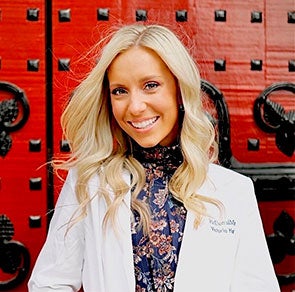 1. Please tell me your name, year in school and any specialties that you’re studying.
1. Please tell me your name, year in school and any specialties that you’re studying.
My name is Victoria Hart. I am a fourth-year dental student at the University of Pittsburgh School of Dental Medicine. My future plans are to continue a career in general dentistry, as I have compounding interest in all fields of dentistry. I am especially interested in prosthodontics, implantology and oral surgery. I most recently have been focusing on my education in implant placement and have completed a course in advanced periodontics focusing on crown lengthening. As a result, I have had the opportunity to successfully place two implants in immediate extraction sockets and was able to complete my first crown lengthening procedure on live patients.
2. How is the School of Dental Medicine’s commitment to implementing new technology enhancing your education and practice opportunities?
Having the opportunity to learn how to use and incorporate new technology into procedural workflows as a predoctoral student is invaluable. In implementing new technology into the clinic, I now have the ability, at such an early point in my career, to understand how much technology can help in my craft. I have found that new technology not only aids in my diagnosis and treatment planning, but also increases patient treatment acceptance. Having the ability to 3D scan and print a patient’s dentition while also taking supplemental intraoral photos increases the patients ultimate understanding while also developing a trustworthy relationship at the forefront of my provider-patient interactions. This has enhanced my education considerably, as I have been able to complete more complex procedures, allowing me to problem solve in an educational setting.
3. Can you tell alumni more about the new digital labs being built at the School of Dental Medicine?
The school recently has implemented an entire clinic and laboratory dedicated to CEREC computer-aided design and manufacturing (CAD/CAM) restorations. We are now able to really focus on digital workflows as they pertain to CEREC (CAD/CAM) and can sit with our clinical faculty and technicians to learn how to create an ideal restoration for our patients. Additionally, we are now able to scan and send cases out to laboratories virtually, as opposed to taking conventional impressions for other traditional restorations. This has created a more streamlined way of communicating with the labs while also increasing the accuracy of the final restorations.
4. In your opinion, how can school-based technology improvements benefit incoming classes of dental medicine students?
Incorporating technology into dental education is truly invaluable. Technology opens a world of possibilities in provider collaboration, communication, assessment and feedback. It gives the dental student a more personalized learning platform and more efficient access to patient resources. Technology opens the possibility of having digital libraries of patients’ previous dental work with providers that have graduated. New technology helps future classes of dentists become more efficient, effective and aligned with the evolving needs in the dental profession.

